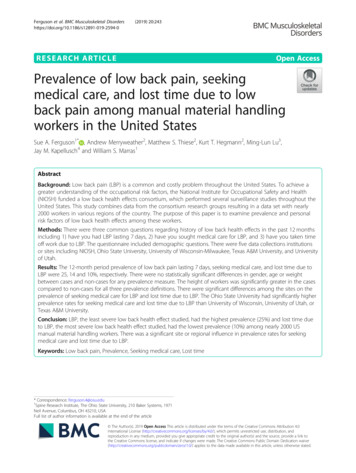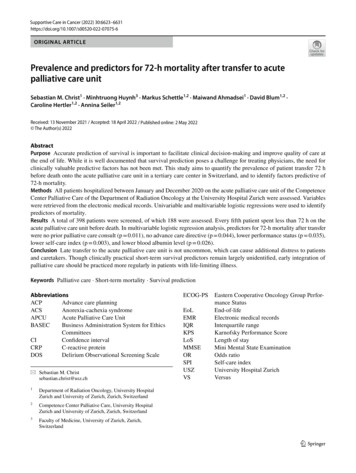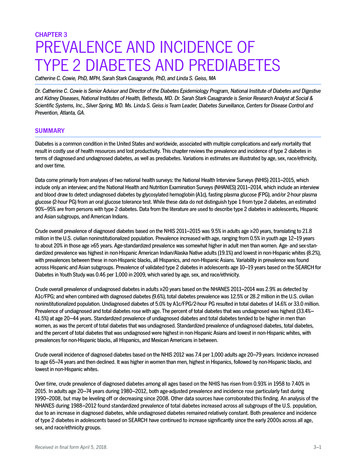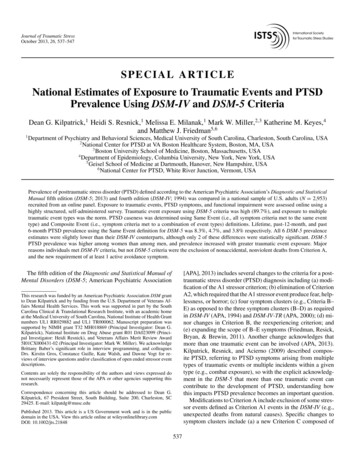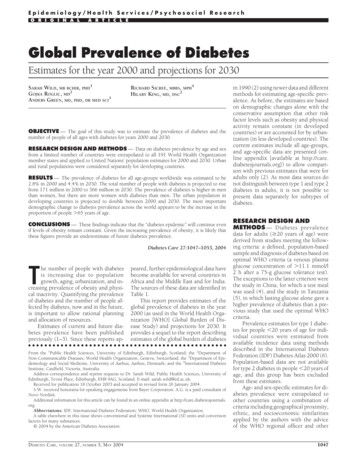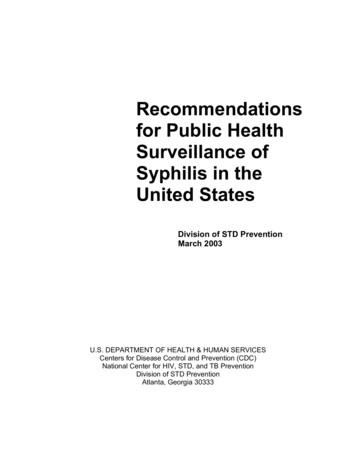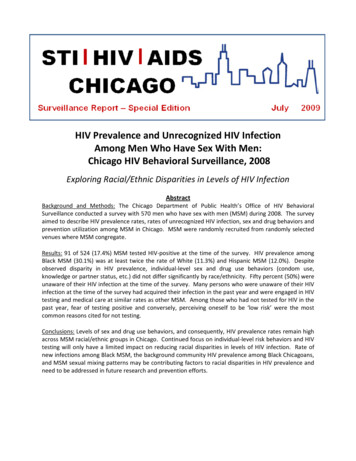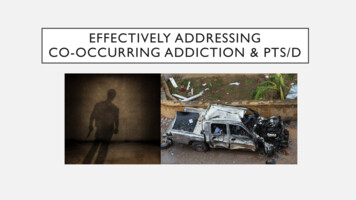
Transcription
AMERICAN JOURNAL OF PREVENTIVE MEDICINE AND PUBLIC HEALTH, 2019VOL 5, NO. 1, PAGE 1–1010.5455/ajpmph.20190627014113ORIGINAL ARTICLE Open AccessPrevalence and predictors of physical activity among community-dwelling older adultsin Mansoura, EgyptNesrine S. Farrag1, Hala S. Abou-Elwafa2, Abdel-Hady El-Gilany1Public Health and Preventive Medicine, Public Health and Community Medicine Department, Faculty of Medicine, MansouraUniversity, Mansoura, Egypt2 Occupational Health and Industrial Medicine, Public Health and Community Medicine Department, Faculty of Medicine, MansouraUniversity, Mansoura, Egypt1 ABSTRACTARTICLE HISTORYIntroduction: Older people represent a growing proportion of the population who oftensuffer from multiple diseases and disabilities. Hence, physical activity is required tomaintain body function and strength.Aims: This study aims to describe the pattern of physical activity of community-dwellingolder adults (60 years and more) and its associated factors in Mansoura, Egypt.Methods: A cross-sectional population-based study was carried out in both urban andrural areas of Mansoura District, Egypt. Self-reported data were collected from a representative sample of 671 participants at their homes. International Physical ActivityQuestionnaire short form was used to assess physical activity. Logistic regression wasused to determine independent predictors of physical activity. p 0.05 was consideredstatistically significant.Results: Results showed that 71.2% of participants had low physical activity level. Higherphysical activity level was associated with male gender; normal weight; younger age;and current work with Adjusted Odds Ratio (95% Confidence Interval)[AOR (95% CI)] of4.2 (2.3–7.6); 3.1 (1.8–5.3); 2.4 (1.4–4.4); 2.8 (1.8–4.2), respectively. The use of assistivedevices, the presence of cardiac disease, or musculoskeletal disease were associatedwith lower physical activity level with AOR (95% CI) of 0.3 (0.2–0.5), 0.3 (0.2–0.6), and0.3 (0.2–0.5), respectively.Conclusions: These findings draw attention of decision makers to the magnitude of theproblem and might help them develop a tailored intervention to tackle physical inactivityin elderly.Received June 27, 2019Accepted September 17, 2019Published October 19, 2019IntroductionWorldwide, the average total life expectancy hasincreased by 5 years between 2000 and 2016 [1],leading to a dramatic shift in the distribution of thepopulation to older ages. This demographic shiftprevails in the whole world, with the most affectedpopulations, in developing countries. It is expectedthat by 2050, 80% of older people will be in low-/middle-income countries [2]. Although this shiftindicates lifestyle and medical advances and carriesgood opportunities to societies and communities,KEYWORDSCommunity; healthy aging;IPAQ; older adults; physicalactivity; risk factorsit brings unintended social, economic, and healthchallenges [3].It is well-known that aging is associated with aprogressive decline in physical and mental functioning [3]. Healthy aging is a short term for a widerconcept that implies allowing people to live healthyand active lives. Early interventions to promotehealthy aging can reduce the prevalence of age-related disability and frailty. Promotion of physicalactivity (PA) is one of the five priority interventions proposed by the World Health OrganizationContact Hala S. Abou-ElWafahalsam2005@gmail.com Occupational Health and Industrial Medicine, Department of Public Healthand Community Medicine, Faculty of Medicine, Mansoura University, Mansoura 35516, Egypt. 2019 The Authors. This is an open access article under the terms of the Creative Commons Attribution NonCommercial ShareAlike 4.0/).
Nesrine S. Farrag, Hala S. Abou-Elwafa, Abdel-Hady El-Gilany(WHO) to improve healthy aging rates [4]. It hadbeen argued that PA is a medicine for older adults[5] and there is good evidence that physical activitypromotes healthy aging [6]. WHO recommends thatolder adults engage in moderate-intensity aerobicPA for at least 150 minute/week, or vigorous-intensity aerobic PA for at least 75 minute/week [7].Physical activity is a multifaceted construct, withno ideal tool to measure all aspects of PA [8]. Thecurrent measures of PA differ in their intendedaims, suitability for different populations, and ability to assess key aspects of PA [i.e., frequency, intensity, time, and type (FITT) in older adults][9].Indirect PA measurements depend on self-reportand are cost-efficient, practical, well accepted, andfeasible on the application for large groups. Also,they relatively interfere little with the habits of theindividual. However, inaccurate recall makes themprone to either over or under-estimation [10,11].Additionally, many indirect tools fail to measurethe lower end of the PA range [12] and are liable tovariations in health status, medical conditions, andcognitive problems [13,14].On the other hand, direct PA measurementsevaluate energy expenditure [10] or actual movement [15]. They are often used to validate indirect measures of PA as they are more accurate, notprone to response, and recall biases. However, theyplace a higher degree of burden on both the participant and the researcher, being more expensive,time-consuming [16,17]. Moreover, individuals maychange their behavior because they know it is beingevaluated [10]. Some measures (e.g., accelerometers, pedometers) offer very inadequate data aboutthe type of activity [13] and are not appropriate formeasuring some types of PA (e.g., swimming, resistance exercise, upper body movements) [10,18].Although PA is well-known for its highly publicized benefits, low physical activity levels werereported among many populations [19–23]. Evidence suggests that programs aimed at increasing PA level among older adults, although heterogeneous, were generally effective in improvingPA level and general wellbeing. However, there isuncertainty about the most effective components ofthese programs [24]. It is recommended that interventions should be tailored to meet the needs of theelderly and should consider social and environmental factors. The presence of multiple co-morbiditiesshould also be considered [22,24].In Egypt, elderly people aged 60 years represents 6.9% of the population, with a total lifeexpectancy of 72.9 years for females and 70.1 for2males, in 2016. There is some form of governmentalcare of geriatric people, including specialized geriatric centers at University hospitals, elderly houses,and clubs mainly concentrated in the capital(Cairo), in addition to some form of social security[25]. However, policymakers and the governmenthave not yet recognized the importance of adoptionof an initiative to improve physical activity levelsamong elderly people. Part of the problem is thatresearchers have not given priority to the researchin that area to provide evidence-based data fordecision-making. Actually, this is the case in mostlow/middle income countries [6,22]. A recent systematic review was conducted to evaluate physicalactivity levels in Arab countries. It included 172studies, only two of them were conducted in Egypt,and neither of these two studies approached thegeriatric population [26]. So, there is a dearth ofknowledge about the pattern of physical activity ofolder adults in Egypt. This study aimed to describethe pattern of physical activity of community-dwelling older adults and its associated factors in Mansoura, Egypt.MethodsStudy design and localityThis cross-sectional descriptive population-basedstudy was carried out in both urban and rural areasof Mansoura District, Egypt during the period fromSeptember 1 to December 31, 2018. Rural areas inEgypt are defined as the areas in which the majority of people work in agriculture, herding, or fishing. On the other hand, urban areas constitute citiesand towns where the majority of the population isworking in industry [27].Target populationOlder adults aged 60 years or more, able to moveunsupported or with the help of assistive devices,and mentally aware.Sample sizeSample size was calculated using Medcalc 15.8(https://www.medcalc.org/). The primary outcome of interest was the prevalence of moderate/high physical activity among older adults. A previous study found that 30% of community rural olderadults had moderate/high physical activity [28].With an alpha error of 5%, study power of 80%, and5% precision, the sample size was 610. Ten percentAm J Prev Med Public Health 2019 Vol 5 Issue 1
Physical activity among older adultswas added to compensate for non-responders, thusthe final sample size was 671 older adults.Sampling methodSample was distributed proportionally between the49 family health units according to the total population. In each health unit, family files were sorted toidentify families with elderly persons from which asystematic sample was selected depending on thesample required and number of total family files.A total of 678 elderly were approached and 635 ofthem completed the questionnaire (response rateof 93.7%).In Egypt, PHC services are provided to familymembers through family health units offering bothpreventive and curative services. Permission wasobtained from the responsible local health authority to access paper files available at each unit fornearly all families.Data collectionData were collected during an interview with olderadults (self-reported) at their homes on a mutuallyagreed day and time as arranged by nurses affiliated to the local health facility. Study questionnairecovered the socio-demographic data of the elderlyand their families, smoking history, medical history of chronic diseases, and International Physical Activity Questionnaire (IPAQ) (short form). Agewas classified into five-year subgroups in order tohave adequate number of persons in each category.The socio-economic scale of El-Gilany et al. [29]was used to assess the socio-economic status of thefamily.Definition of variablesSmoking index (SI)It was calculated according to Indrayan [30] thatincorporates age at initiation of smoking, durationof smoking, quantity of smoking, type of tobaccoconsumption including passive smoking, number ofcigarettes (or others) smoked per day, and numberof years elapsed since quitting. SI was classified intothree categories 0, 20, and 20 [30].International Physical Activity Questionnaire (shortform) (IPAQ-S)Physical activity was calculated using (IPAQ-S).The Arabic version is available at (http://www.ipaq.ki.se). (IPAQ-S) evaluates physical activityundertaken across a comprehensive set of domainswww.ajpmph.comincluding; leisure time physical activity, domesticand gardening (yard) activities, work-related physical activity, and transport-related physical activity.IPAQ-S provides separate scores on walking, moderate-intensity activities, and vigorous-intensityactivities. Calculation of the total score for (IPAQ-S)requires the summation of the duration (in minutes) and frequency (days) of walking, moderate-intensity activities, and vigorous-intensityactivities so that activity can be classified into threedifferent grades (low, moderate, and high) according to specific formulates [31]. Both categorical andcontinuous indicators of PA are possible from bothIPAQ forms. However, energy expenditure in manypopulations follows non-normal distribution, soit is recommended that the continuous indicatorbe presented as median minute/week or medianMET–minute/week rather than means (for example, mean minute/week or mean MET-minute/week). METs are multiples of the resting metabolicrate and a MET-minute is calculated by multiplyingthe MET score of an activity by the minutes performed [28]. Based on their level of PA, individualscan fall in one of three categories; low, moderate,and high.1. Category 1 (Low PA) involves individuals whodo not meet criteria for Categories 2 or 3.2. Category 2 (Moderate PA) involves individualswho meet any of the following criteria; (a) 3or more days of vigorous-intensity activity ofat least 20 minutes per day, OR (b) 5 or moredays of moderate-intensity activity and/orwalking of at least 30 minutes per day, OR (c)5 or more days of any combination of walking,moderate-intensity activities, or vigorous-intensity activities achieving a minimum TotalPA of at least 600 MET-minute/week.3. Category 3 (High PA) involves individuals whomeet one of two criteria; (a) vigorous-intensity activity on at least 3 days achieving a minimum Total PA of at least 1,500 MET-minute/week, OR (b) 7 or more days of any combination of walking, moderate-intensity activities,or vigorous-intensity activities achieving aminimum Total PA of at least 3,000 MET-minute/week [32].Body mass indexIt is defined as “the weight in kilograms divided bythe square of height in meters (kg/m2)”. Overweightmeans BMI 25, while obesity means BMI 30 [33].3
Nesrine S. Farrag, Hala S. Abou-Elwafa, Abdel-Hady El-GilanyData analysisData were analyzed using SPSS (Statistical Package for Social Sciences) version 16. Variables werepresented as number and percent. MET of physicalactivity was presented as median (minimum–maximum). Chi square was used to test the significancein bivariate analysis and crude odds ratios (COR)and their 95% CI were calculated. Variables significantly associated with PA in bivariate analysiswere entered into a multivariate logistic regressionmodel using the Stepwise Forward Wald method.Adjusted OR and their 95% CI were calculated. p 0.05 was considered statistically significant.ResultsThe current study included 635 participants aged60–86 years, with a mean of 66.1 5.3. About 44%of participants were women, around 65% wererural, 55% were still working, and 67% were stillmarried. Nearly, half of the participants were illiterate and had low/very low socioeconomic standard.PA profile of participants showed that the average (median) MET value for walking was 330MET-minute/week. The average (median) totalphysical activity score was 346.5 MET-minute/week.Around 71% of participants were classified as lowphysical activity group, while only 8.8% had highphysical activity level (Table 1).The association between moderate/high physical activity and socio-demographic characteristics is displayed in Table 2. The moderate/highPA was nearly three and two times higher amongage groups (60– 65 years, and 65– 70 years)Table 1. Physical activity profile of 635 older adults inMansoura, Egypt, 2018.Items*Mean (SD)Median(Min–max)MET walking348.95(261.42) 330.0(0–1386.0)MET moderate111.43(434.33)0(0–3360.0)MET vigorous74.83(520.17)0(0–6720.0)MET total535.22(745.7)346.5(0–7066.5)N (%)Physical activitylevel:Low ( 600 MET)452 (71.2)Moderate (6002,999.9 MET)127 (20.0)High ( 3,000MET)*Measure in (MET-minute/week).456 (8.8)compared to age group 70 [COR (95%CI): 2.7(1.6–4.6), 1.9 (1.1–3.3), respectively]. Similarly,it was two times higher among men compared towomen, and rural participants compared to urbanones [COR (95%CI): 2.0 (1.4–2.9), 1.9 (1.3–2.8),respectively]. Low educational level and very low/low socioeconomic standard were associated witharound two times higher moderate/high PA compared to high education level and high socioeconomic standard [COR (95%CI): 2.7 (1.5–4.8), 2.4(1.4–4.1), respectively]. The working situation ofparticipants significantly predicts their moderate/high PA, as being currently working increased PAnearly three times [COR (95%CI): 2.8 (2.0–4.0)].Also, working as an employee before retirementwas significantly associated with lower PA [COR(95%CI): 0.6 (0.3–0.98)].The moderate/high PA was more than twotimes higher in normal weight participants and innon-smokers compared to obese ones and heavysmokers [COR (95%CI): 2.3 (1.5–3.5), 2.2 (1.01–4.8), respectively] (Table 3). The use of assistivedevices was associated with a significant decreasein moderate/high PA level [COR (95%CI): 0.3(0.2–0.5)]. Apart from hypertension, renal diseases, anddiabetes mellitus, most of the studied chronic diseases were associated with significant decreases inmoderate/high PA level (i.e., cardiac disease (COR(95%CI): 0.4(0.2–0.8)], respiratory diseases [COR(95%CI): 0.4(0.2–0.8)], liver disease [COR (95%CI):0.5(0.3–0.8)], and musculoskeletal disease [COR(95%CI): 0.3(0.2-0.5)]).Multiple regression analysis showed that amongsocio-demographic characteristics, age, gender, andbeing currently working are significant independent predictors of moderate/high PA level (Table 4).The role of gender in the prediction was doubledwith Adjusted Odds Ratio (95% Confidence Interval) [AOR: 95%CI, 4.2(2.3–7.6)]. BMI and the useof assistive devices are significant independentpredictors. Being of normal weight, older adultsare more likely to perform moderate/high physicalactivity [AOR (95%CI): 3.1(1.8–5.3)]. The presenceof cardiac disease and musculoskeletal diseases aswell as not using assistive devices predict lowermoderate/high PA [AOR (95%CI): 0.3(0.2–0.6),0.3(0.2–0.5), and 0.3(0.2–0.5), respectively].DiscussionThe study revealed that the level of physical activity among older adults in Mansoura, Egypt is nothigher than many other elderly populations. MoreAm J Prev Med Public Health 2019 Vol 5 Issue 1
Physical activity among older adultsTable 2. Prevalence of moderate/high physical activity (PA) and its variation with socio-demographic characteristics of older adults, Mansoura, Egypt, 2018.Socio-demographic characteristicsOverallAge (years)GenderMarital statusResidenceEducation levelIncomeModerate/high PAN (%)pCOR (95%CI)635183 (28.8)60 289102 (35.3) 0.0012.7 (1.6–4.6)65 21459 (27.6)0.021.9 (1.1–3.3)70 13222 (16.7)1(r)Women282104 (36.9)2.0 (1.4–2.9)Men35379 (22.4)Married426131 (30.8)Widow/Divorced/single20952 (24.9)Rural412137 (33.3)Urban22346 (20.6)Illiterate305104 (34.1) 0.0012.7 (1.5–4.8)Less than secondary15343 (28.1)0.032.0 (1.1–3.8)Secondary7020 (25.6)0.0522.1 (0.98–4.3)(25.3–32.4) 0.0010.1 0.0011(r)1.3 (0.9–2.0)1 (r)1.9 (1.3–2.8)1 (r)University9916 (16.2)Enough367110 (30.0)0.81.1 (0.7–1.6)More than enough8821 (23.9)0.40.8 (0.4–1.4)Not enough18052 (28.9)0.81 (r)305104 (34.1) 0.0012.4 (1.4–4.1)20557 (27.8)0.041.8 (1.04–3.1)High12522 (17.6)Employee30369 (23.4)0.040.6 (0.3–0.98)Housewife19361 (31.6)0.60.9 (0.5–1.6)Farmer/ manual worker7330 (41.1)0.41.3 (0.7–2.6)Others6623 (34.8)22461 (27.2)Socio-economic Very low/lowstatusMiddlePreviousoccupationTotalNLiving condition AloneWith family411122 (29.7)CurrentlyworkingNo282114 (40.4)Yes35369 (19.5)Social activitiesparticipationYes15768 (43.3)No478115 (24.1)1 (r)1 (r)1 (r)0.5 0.001 0.0010.9 (0.6–1.3)1 (r)2.8 (2.0–4.0)1 (r)2.4 (1.7–3.5)1 (r)COR crude odds ratio CI Confidence interval, r reference group r-reference category.than 70% of the elderly had a low PA level, whilearound 8% only had a high PA level. This resultshowed that the median of MET moderate PA andMET vigorous PA was (0 MET-min/week), compared to walking (330 MET-minute/week). Thisagrees with a clinic-based previous study in Fayoum governorate, Egypt, that indicated 57% of theelderly did not meet the WHO recommendations ofPA for the elderly [34]. Low level of PA in Egypt wasreported by one small-scale study on older adultsresident in elderly homes [35].The low PA level is a common finding reportedby many studies. Only a quarter of people agedwww.ajpmph.commore than 65 in England meet the recommendedPA to maintain health [3]. Hong reported that 70%of Korean older adults were never physically active,and only 12.5% perform the recommended amountof PA [36]. Also, more than half of Thai rural elderlypeople were physically inactive [19]. Ramires et al.[23] reported a low level of physical activity from apopulation-based sample of older adults in a Southern city of Brazil, using triaxial accelerometry datain the assessment of PA level.PA level was significantly associated with manyof the socio-demographic factors. There is a significant negative association between age and PA. The5
Nesrine S. Farrag, Hala S. Abou-Elwafa, Abdel-Hady El-GilanyTable 3. Prevalence of moderate/high physical activity (PA) and its variation with clinicalparameters of older adults, Mansoura, Egypt, 2018.Clinical parameterTotalTotalModerate/high PAN (%)pCOR (95% CI)BMINormal23087 (36.9) 0.0012.3 (1.5–3.5)Overweight20356 (27.6)0.11.5 (0.9–2.4)Obese19640 (20.4)Zero/non-smoker485157 (32.4) 2010518 (17.1)20 & more458 (17.8)Yes22033 (15.0)No415150 (36.1)Yes9315 (16.1)No542168 (31.0)Yes6510 (15.4)No570173 (30.4)Yes11321 (18.6)Smoking indexUse assisted devicesCardiac diseaseRespiratory diseaseLiver diseaseNo522162 (31.0)MusculoskeletaldiseaseYes28547 (16.5)No350136 (38.9)HypertensionYes30979 (25.6)No326104 (31.9)Yes224 (18.2)No613179 (29.2)Yes20653 (25.7)No429130 (30.3)Renal diseaseDiabetes mellitus1 (r) 0.001 2.2 (1.01–4.8)0.90.9 (0.4–2.4)1 (r) 0.0010.0030.3 (0.2–0.5)1 (r)0.4 (0.2–0.8)1 (r)0.010.4 (0.2–0.8)1 (r)0.0080.5 (0.3–0.8)1 (r) 0.0010.080.30.20.3 (0.2–0.5)1 (r)0.7 (0.5–1.0)1 (r)0.6 (0.2–1.6)1 (r)0.7 (0.5–1.2)1 (r)BMI Body mass index, COR crude odds ratio, CI Confidence interval, r reference group.same association was reported by many studies[3,23,37] among which a population-based, nationwide, cohort study in Germany [37] and a studyconducted using objective assessment [23]. Lessphysical functioning, perceiving PA as inappropriate or even harmful in older age, partly explain thisnegative association. Also, self-efficacy and mobility may have their role in limiting PA in the elderly[23]. However, a borderline significant associationwas found among Korean men, but not in women[36]. Also, no significant association was observedamong elderly people in Thailand.The association of gender and PA was evident inthe bivariate analysis and more evident with regression analysis, which showed that men were fourtimes higher than women. Similarly, Hong reportedthat PA activity was significantly higher among menespecially with regard to vigorous activity [36]. Onthe other hand, Ethisan reported a higher activitylevel among rural women in Thailand (OR: 95%CI, 2.98:1.70–5.23) [19]. In Germany, Manz et al.[37] found no association in a cohort, nationwide6study. A recent systematic review concluded thatthe association of PA with gender is inconsistentand it needs to be studied within specific domainsof PA, having different profiles of PA among menand women [38]. While more work-related PA, PAfor transportation, and vigorous PA were reportedamong men, more light PA and house-related PAwere reported by women [23,38].The rural participants were more physically activethan the urban. The effect of residence on PA amongelderly varies widely between studies dependingon each community’s characteristics, prevailingwork, and leisure-activity culture. Also, the socialand physical environments modify, promote, or suppress PA. For example, Muntner et al. [39] reporteda higher PA level among rural Chinese older adults(52.7%) compared with urban counterparts (9.8%),and most of this PA is work-related. Rural Americanolder women were more sedentary than urban ones,with special reference to leisure time activity. Caregiving was the most cited barrier [40]. In Poland, thePA level was higher among older adults residing inAm J Prev Med Public Health 2019 Vol 5 Issue 1
Physical activity among older adultsTable 4. Multivariate logistic regression analysis ofindependent predictors of moderate/high physical activityamong older adults, Mansoura, Egypt, 2018.PredictorsAge (years)GenderCurrently workingBMIUse assisted devicesCardiac diseaseMusculoskeletaldiseaseConstantModel cΒpAOR (95% CI)60–640.90.0032.4 (1.4–4.4)65–690.40.21.5 (0.8–2.9) 70-Men1.4Women-No1.0Yes-1 (r) 0.001 0.0014.2 (2.3–7.6)1 (r)2.8 (1.8–4.2)1 (r)Normal1.1 0.0013.1 (1.8–5.3)Overweight0.40.11.5 (0.9–2.6)Obese-Yes 1.2No-Yes 1.2No-Yes 1.1No-1 (r) 0.0010.001 0.0010.3 (0.2–0.5)1 (r)0.3 (0.2–0.6)1 (r)0.3 (0.2–0.5)1 (r) 2.542183.5, 0.001% correctly predicted77.8BMI Body mass index, AOR Adjusted odds ratio,CI Confidence interval, r reference category.#The model included (age, gender, residence, education level,socioeconomic status, previous occupation, current working,social activities participation, BMI, smoking index, use of assisteddevices, cardiac disease, respiratory disease, liver disease, andmusculoskeletal disease) which were the significant predictors inbivariate analysis.urban areas. Most of the difference was referred toeducation level and professional achievement whichincrease awareness to spend time in activities otherthan watching television. Also, access to leisure,sports, and social facilities available in urban areasplays another important role [41].The study showed that physical activity level wassignificantly lower among participants with highereducation and socioeconomic standard (SES), whileincome was not associated with PA. All these variables were non-significant after adjusting for othervariables. Similarly, Ramires et al. [23] found thesame negative association in their study whichused objective assessment of PA. On the otherhand, Manz et al. reported that higher PA level wasobserved among older adults of middle and highSES than others in Germany [37]. Notthoff et al. [38]found inconsistent association between educationand total PA score. A clue to clarify the associationwww.ajpmph.comwas the study conducted by Kolbe-Alexander et al.who found that high SES individuals experience significantly higher leisure-time PA, and less transportPA compared to lower SES individuals. The Low SESpeople tend to walk, cycle, and use transport [42].While countries like Germany have appropriatesocial and material resources and more PA friendlyneighborhoods, a country like Egypt does not,which may partly explain the lower activity levelamong older adults with a higher SES.Our study indicated that having a spouse or not,living alone or not, did not affect the PA level amongthe elderly. The same non-significant associationof marriage with PA was found in 11 studies asreported by Notthoff et al. [38]. On the other hand,Ramires et al. [23] reported a higher PA level amongmarried women, but this association was insignificant for men. Similarly, Manz, et al. [37] found asignificant higher PA level among older adults withsocial support, but no association between PA andbeing married.The current working status was a highly significant predictor of PA level, even after adjusting forthe effect of other variables. The same significantassociation was found by Ramires et al. [23] in theirstudy in which an objective assessment of PA wasused. Retirement from work significantly reducesPA level [3], and this association can explain whyparticipants who worked as employees had thelowest PA level, in our study. That is because, inEgypt, employees are the sector who retires at theage of 60 years, while others (e.g., manual workersor farmers) may continue to work after 60 years ofage. Similarly, the elderly who participated in socialactivities showed two times higher PA level compared to others who did not.Obesity is one of the problems that limit PAamong people of any age and especially among theelderly. Even after adjusting for other variables,participants with normal weight were three timesmore active than obese participants. Similarly,some studies reported no association between obesity and PA [23,37]. The association of obesity andphysical activity can run in two opposite directions.Obesity may result from physical inactivity and canact as a stimulator for more PA to improve obesity.This makes it difficult to assess the relationship[37]. Smoking was a non-significant independentpredictor of PA, although PA was two times higheramong nonsmokers compared to those with asmoking index of 20 or more. Similarly, participantssuffering a respiratory disease showed a lower7
Nesrine S. Farrag, Hala S. Abou-Elwafa, Abdel-Hady El-GilanyPA level, although this effect did not persist afteradjusting for other variables. Similarly, Manz et al.[37] reported that smoking was not associated withaerobic PA 1 day/week in their cohort study.Use of an assistive device is a coping strategythat helps older adults overcome limitations inself-care and mobility activities. However, their useof these devices may force them to publicly admittheir limitations, bringing disability stigma [43]. Inthis study, the use of assistive devices was associated with a significant reduction in moderate/highPA level. Similarly, activity limitation significantlyreduces PA in Korean women [36].Chronic diseases may act as a barrier or a trigger of PA, being a part of therapy, which may blurthe association of chronic disease and PA [37]. Onlythe presence of cardiac disease was an independentpredictor of lower PA level. Patients of chronic cardiac disease should be enrolled in a rehabilitationprogram, with the main core is closely monitoredphysical activity. After that, they should be encouraged to adopt an active lifestyle. Unsubstantiatedconsiderations related to safety may be the reason for under-prescription of physical activity tocardiac patients [44]. In addition, low PA amongparticipants with cardiac co-morbidity may bedue to self-perceived poor health [23,38]. One ofthe important diseases that limit mobility and, ofcourse, physical activity is arthritis [45]. However,not all studies, supported this finding [36]. Interventions to promote exercise among patients werefound effective in improving the physical, mental,and social domains of health. The challenge is tomaintain this activity level after any intervention[45]. All other chronic diseases were not predictorsof PA level. The same results were found by somestudies [36,37].Therefore, a successful intervention to tackle physical inactivity should be tailored for each community according to predetermined associated factors.Innovative collaborative work is urgently neededto reduce physical inactivity among older adults,to decrease the effects of non-communicable diseases, and preserve their muscle strength. C
University, Mansoura, Egypt 2 Occupational Health and Industrial Medicine, Public Health and Community Medicine Department, Faculty of Medicine, Mansoura Contact Hala S. Abou-ElWafa halsam2005@gmail.com Occupational Health and Industrial Medicine, Department of Public Health

